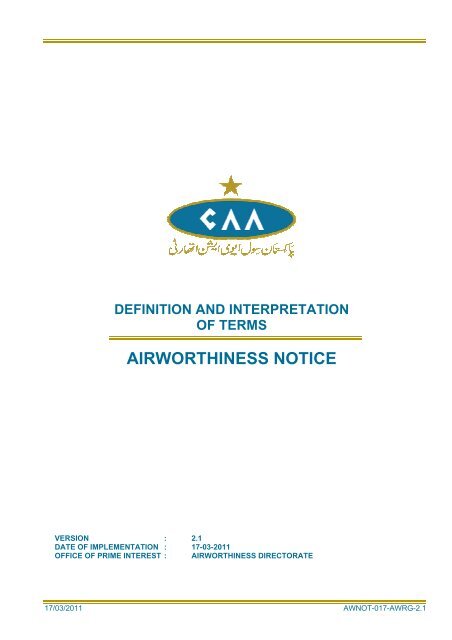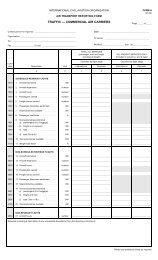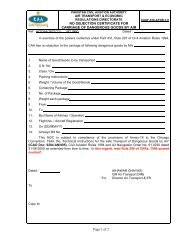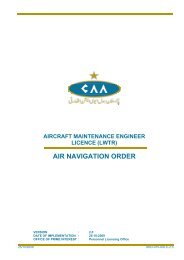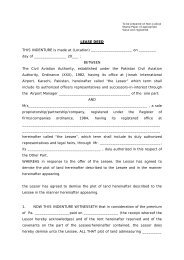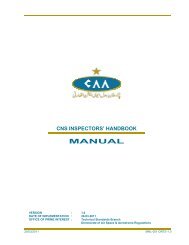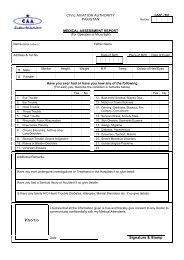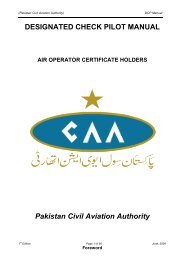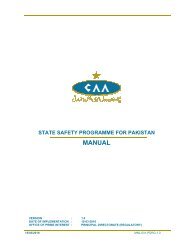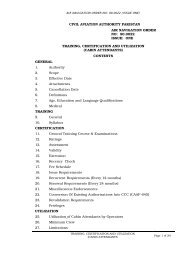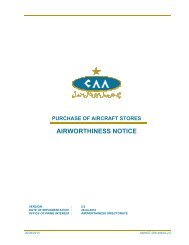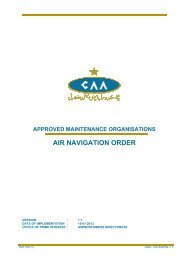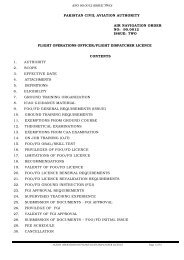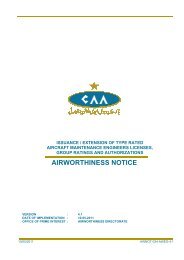AWNOT-017-AWRG-2.1 dated 17th March 2011 - Civil Aviation ...
AWNOT-017-AWRG-2.1 dated 17th March 2011 - Civil Aviation ...
AWNOT-017-AWRG-2.1 dated 17th March 2011 - Civil Aviation ...
You also want an ePaper? Increase the reach of your titles
YUMPU automatically turns print PDFs into web optimized ePapers that Google loves.
DEFINITION AND INTERPRETATIONOF TERMSAIRWORTHINESS NOTICEVERSION : <strong>2.1</strong>DATE OF IMPLEMENTATION : 17-03-<strong>2011</strong>OFFICE OF PRIME INTEREST : AIRWORTHINESS DIRECTORATE17/03/<strong>2011</strong> <strong>AWNOT</strong>-<strong>017</strong>-<strong>AWRG</strong>-<strong>2.1</strong>
DEFINITION AND INTERPRETATION OF TERMS17/03/<strong>2011</strong> <strong>AWNOT</strong>-<strong>017</strong>-<strong>AWRG</strong>-<strong>2.1</strong>
DEFINITION AND INTERPRETATION OF TERMSA. AUTHORITY:A1. This Airworthiness Notice is issued under the authority vested in DG CAA vide Rule No. 4, 5, 180and 360 of <strong>Civil</strong> <strong>Aviation</strong> Rules 1994B. PURPOSE:B1. The purpose of this Airworthiness Notice is to elaborate the definitions and interpretations of theterms acceptable to PCAA.C. SCOPE:C1. This Airworthiness Notice is applicable to all operators maintenance organizations and AME’s.D. DESCRIPTION:D1. DEFINITIONS:D1.1 The following terms when used in this ANO, have the meanings assigned to themrespectively. Any term used in this ANO but not defined, shall have the same meaningas given in the <strong>Civil</strong> <strong>Aviation</strong> Ordinance, 1960, Pakistan <strong>Civil</strong> <strong>Aviation</strong> AuthorityOrdinance 1982, CARs, 1994 and relevant ICAO Annexes.D2. ADJUSTMENTS AND TESTING:D<strong>2.1</strong> The methods of completing the adjustments or tests which may be required duringservice or to correct faults e.g. control movements with permissible tolerances.D3. AEROPLANE:D3.1 A power-driven heavier-than-air aircraft, deriving its lift in flight chiefly from aerodynamicreactions on surfaces which remain fixed under given conditions of flight.D4. AIRCRAFT:D4.1 Any machine that can derive support in the atmosphere from the reactions of the airother than the reactions of the air against the earth’s surface.D5. AIRCRAFT COMPONENTS:D5.1 Means any part, the soundness and correct functioning of which, when fitted on anaircraft, is essential to the continued Airworthiness or safety of the aircraft, or itsoccupants.D6. AIRSHIP:D6.1 An airship means a power driven lighter-than-air aircraft.D6.2 UAV: Means unmanned aircraft (other than a balloon or a kite) whose intendedpurpose is other than recreational use.D6.3 Small UAV Airship: Means an Airship UAV with a volume less than or equal to 100cubic meters and a gross weight of over a 100 grams.D6.4 URCSUA: “Un-Manned Remotely Controlled Small Uav Airship” is a small UAV airship.17/03/<strong>2011</strong> Page 1 of 10 <strong>AWNOT</strong>-<strong>017</strong>-<strong>AWRG</strong>-<strong>2.1</strong>
DEFINITION AND INTERPRETATION OF TERMSD7. AIRWORTHY:D7.1 The status of an aircraft, engine, propeller or part when it conforms to its approveddesign and is in a condition for safe operation.D8. ANTICIPATED OPERATING CONDITIONS:D8.1 Those conditions which are known from experience or which can be reasonablyenvisaged to occur during the operational life of the aircraft taking into account theoperations for which the aircraft is made eligible, the conditions so considered beingrelative to the meteorological state of the atmosphere, to the configuration of terrain, tothe functioning of the aircraft, to the efficiency of personnel and to all the factors affectingsafety in flight. Anticipated operating conditions do not include:D8.1.1 those extremes which can be effectively avoided by means of operatingprocedures; andD8.1.2 those extremes which occur so infrequently that to require the Standards to bemet in such extremes would give a higher level of airworthiness than experiencehas shown to be necessary and practical.D9. APPROPRIATE AIRWORTHINESS REQUIREMENTS:D9.1 The comprehensive and detailed airworthiness codes established, adopted or acceptedby PCAA for the class of aircraft, engine or propeller under consideration.D10. APPROVED:D10.1 Accepted by PCAA as suitable for a particular purpose.D11. ASSEMBLY:D11.1 That items are put together fitted, assembled, attached, installed, connected, secured oradjusted correctly in the approved manner.D12. CATEGORY A:D1<strong>2.1</strong> With respect to helicopters, means a multi-engine helicopter designed with engine andsystem isolation features specified in Part IVB of Annex-8 and capable of operations usingtake-off and landing data scheduled under a critical engine failure concept which assuresadequate designated surface area and adequate performance capability for continuedsafe flight or safe rejected take-off.D13. CATEGORY B:D13.1 With respect to helicopters, means a single-engine or multi-engine helicopter which doesnot meet Category A standards. Category B helicopters have no guaranteed capability tocontinue safe flight in the event of an engine failure, and a forced landing is assumed.D14. CERTIFICATE OF MAINTENANCE REVIEW:D14.1 This certificate is issued as per approved maintenance schedule certifying that:D14.2 All maintenance specified in the approved maintenance schedule has been carried outwithin the prescribed time period.17/03/<strong>2011</strong> Page 2 of 10 <strong>AWNOT</strong>-<strong>017</strong>-<strong>AWRG</strong>-<strong>2.1</strong>
DEFINITION AND INTERPRETATION OF TERMSD14.3 All modifications and inspections classified as Mandatory by PCAA have been carriedout within the prescribed time periods.D14.4 All reported defects have been rectified or deferred as per PCAA approved procedures.D14.5 All Certificates of Release to Service required have been issued as per PCAArequirements.D15. CERTIFICATE OF RELEASE TO SERVICE:D15.1 This certificate is issued after inspection, repair, overhaul, modification and replacementon aircraft, its engines, propellers, components, instruments and radios and theirinstallation as is necessary for the Airworthiness of the aircraft.D16. CONDITION:D16.1 The physical state of an item.D17. CONFIGURATION (AS APPLIED TO THE AEROPLANE):D17.1 A particular combination of the positions of the moveable elements, such as wing flapsand landing gear, etc., that affect the aerodynamic characteristics of the aeroplane.D18. CONTINUING AIRWORTHINESS:D18.1 The set of processes by which an aircraft, engine, propeller or part complies with theapplicable airworthiness requirements and remains in a condition for safe operationthroughout its operating life.D19. CRITICAL ENGINE(S):D19.1 Any engine whose failure gives the most adverse effect on the aircraft characteristicsrelative to the case under consideration.Note.— On some aircraft there may be more than one equally critical engine. In this case, theexpression “the critical engine” means one of those critical engines.D20. DEFECT:D20.1 Defect means a condition existing in an aircraft (including its systems) or aircraftcomponent arising from any cause other than damage, which would preclude it oranother aircraft component from performing their intended functions or would reduce theexpected service life of the aircraft or aircraft component.D20.1.1 Major defect: means a defect of such nature that reduces the safety of theaircraft or its occupants and includes defects discovered as a result of theoccurrence of any emergency or in the course of normal operation ormaintenance.D20.1.2 Repetitive defect: means a defect in an aircraft (including in its componentsand system) which recurs, in spite of rectification attempt, on the same aircraftor on another aircraft of the same type.17/03/<strong>2011</strong> Page 3 of 10 <strong>AWNOT</strong>-<strong>017</strong>-<strong>AWRG</strong>-<strong>2.1</strong>
DEFINITION AND INTERPRETATION OF TERMSD21. DESIGN LANDING MASS:D21.1 The maximum mass of the aircraft at which, for structural design purposes, it is assumedthat it will be planned to land.D22. DESIGN TAKE-OFF MASS:D2<strong>2.1</strong> The maximum mass at which the aircraft, for structural design purposes, is assumed tobe planned to be at the start of the take-off run.D23. DESIGN TAXIING MASS:D23.1 The maximum mass of the aircraft at which structural provision is made for load liable tooccur during use of the aircraft on the ground prior to the start of take-off.D24. DISCRETE SOURCE DAMAGE:D24.1 Structural damage of the aeroplane that is likely to result from: impact with a bird,uncontained fan blade failure, uncontained engine failure, uncontained high-energyrotating machinery failure or similar causes.D25. ENGINE:D25.1 A unit used or intended to be used for aircraft propulsion. It consists of at least thosecomponents and equipment necessary for functioning and control, but excludes thepropeller/rotors (if applicable).D26. FACTOR OF SAFETY:D26.1 A design factor used to provide for the possibility of loads greater than those assumed,and for uncertainties in design and fabrication.D27. FAULTS AND RECTIFICATION:D27.1 The faults which may arise during service or those which may be found as a result ofinspection, together with suggested causes and recommended methods of rectification.D28. FINAL APPROACH AND TAKE-OFF AREA (FATO):D28.1 A defined area over which the final phase of the approach manoeuvre to hover orlanding is completed and from which the take-off manoeuvre is commenced. Where theFATO is to be used by performance Class 1 helicopters, the defined area includes therejected take-off area available.D29. FIREPROOF:D29.1 The capability to withstand the application of heat by a flame for a period of 15 minutes.D30. FIRE RESISTANT:D30.1 The capability to withstand the application of heat by a flame for a period of 5 minutes.D31. FUNCTIONING:D31.1 Correct operation in the approved manner.17/03/<strong>2011</strong> Page 4 of 10 <strong>AWNOT</strong>-<strong>017</strong>-<strong>AWRG</strong>-<strong>2.1</strong>
DEFINITION AND INTERPRETATION OF TERMSD32. GYROPLANE:D3<strong>2.1</strong> A heavier-than-air aircraft supported in flight by the reactions of the air on one or morerotors which rotate freely on substantially vertical axes.D33. HELICOPTER:D33.1 A heavier-than-air aircraft supported in flight chiefly by the reactions of the air on one ormore power-driven rotors on substantially vertical axes.D34. HUMAN FACTORS PRINCIPLES:D34.1 Principles which apply to aeronautical design, certification, training, operations andmaintenance and which seek safe interface between the human and other systemcomponents by proper consideration to human performance.D35. HUMAN PERFORMANCE:D35.1 Human capabilities and limitations which have an impact on the safety and efficiency ofaeronautical operations.D36. INSPECTION:D36.1 The determination of the condition of a component, assembly or structure etc. by sight,feel, measurement or other means.D36.2 The physical act of inspecting is part of any work, which constitutes overhaul,modification, replacement or repair and such inspection is covered by the certificationrequired for the work. Where the work is the inspection itself, such inspections requiringcertification are indicated by the PCAA Airworthiness Directorate or AirworthinessAuthorities of the relevant State of Design / manufacture of the aircraft and equipment.D37. LANDING SURFACE:D37.1 That part of the surface of an aerodrome which the aerodrome authority has declaredavailable for the normal ground or water run of aircraft landing in a particular direction.D38. LIMIT LOADS:D38.1 The maximum loads assumed to occur in the anticipated operating conditions.D39. LOAD FACTOR:D39.1 The ratio of a specified load to the weight of the aircraft, the former being expressed interms of aerodynamic forces, inertia forces, or ground reactions.D40. MAINTENANCE:D40.1 The performance of tasks required to ensure the continuing airworthiness of an aircraft,including any one or combination of overhaul, inspection, replacement, defectrectification, and the embodiment of a modification or repair.17/03/<strong>2011</strong> Page 5 of 10 <strong>AWNOT</strong>-<strong>017</strong>-<strong>AWRG</strong>-<strong>2.1</strong>
DEFINITION AND INTERPRETATION OF TERMSD41. MODIFICATION:D41.1 A modification to an aeronautical product means a change to the type design which isnot a repair:D41.2 Major: A major modification means a type design change not listed in the aircraft, aircraftengine or propeller specifications:D41.<strong>2.1</strong> That might appreciably affect the mass and balance limits, structural strength,performance, power plant operation, flight characteristics or other qualitiesaffecting Airworthiness or environmental characteristics; orD41.2.2 That will be embodied in the product according to non-standard practices.D41.3 Minor: A minor modification means a modification other than a major modification.D42. ORNITHOPER:D4<strong>2.1</strong> A heavier-than-air aircraft supported in flight chiefly by the reactions of the air on planesto which a flapping motion is imparted.D43. OVERHAUL:D43.1 An overhaul is a major work of operation, which involves dismantling, bench testing andrenewal of operating life. Servicing of items such as piston engine spark plugs is notconsidered to constitute overhaul, neither is "top overhaul" of a piston engine. Thecomplete work concerned with renewal of a Certificate of Airworthiness does notnecessarily constitute overhaul and each work operation must be considered individually.Whenever doubt exists reference should be made to the Airworthiness Directorate.D44. PERFORMANCE CLASS 1 HELICOPTER:D44.1 A helicopter with performance such that, in case of engine failure, it is able to land on therejected take-off area or safely continue the flight to an appropriate landing area.D45. PERFORMANCE CLASS 2 HELICOPTER:D45.1 A helicopter with performance such that, in case of engine failure, it is able to safelycontinue the flight, except when the failure occurs prior to a defined point after take-off orafter a defined point before landing, in which cases a forced landing may be required.D46. PERFORMANCE CLASS 3 HELICOPTER:D46.1 A helicopter with performance such that, in case of engine failure at any point in the flightprofile, a forced landing must be performed.D47. POWERPLANT:D47.1 The system consisting of all the engines, drive system components (if applicable), andpropellers (if installed), their accessories, ancillary parts, and fuel and oil systemsinstalled on an aircraft but excluding the rotors for a helicopter.17/03/<strong>2011</strong> Page 6 of 10 <strong>AWNOT</strong>-<strong>017</strong>-<strong>AWRG</strong>-<strong>2.1</strong>
DEFINITION AND INTERPRETATION OF TERMSD48. PRESSURE-ALTITUDE:D48.1 An atmospheric pressure expressed in terms of altitude which corresponds to thatpressure in the Standard Atmosphere.D49. PROCEDURE:D49.1 The methods to be used for implementing the recommended schedule, e.g. methods ofaccess to specified parts, the methods of inspection etc.D50. RENDERING (A CERTIFICATE OF AIRWORTHINESS) VALID:D50.1 The action taken by a Contracting State, as an alternative to issuing its own Certificate ofAirworthiness, in accepting a Certificate of Airworthiness issued by any other ContractingState as the equivalent of its own Certificate of Airworthiness.D51. REPAIR:D51.1 The restoration of an aeronautical product to an airworthy condition as defined by theappropriate airworthiness requirements.D51.2 Major repair: A major repair means a design change which is intended to restore anaeronautical product to an airworthy condition:D51.<strong>2.1</strong> Where the damage being repaired might appreciably affect the structuralstrength, performance, power-plant operations, flight characteristic, or otherqualities affecting Airworthiness or environmental characteristic.D51.2.2 That will be embodied in the product using non-standard practices.D51.3 Minor repair: A minor repair means a repair other than a major repair.D52. REPLACEMENT:D5<strong>2.1</strong> A replacement is a work operation, which involves the removal and replacement of thesame part for the substitution of another similar part. The opening and closing ofinspection covers, access latches, exits, cowlings etc., is not considered to constitutereplacement.D53. ROTORCRAFT:D53.1 A power-driven heavier-than-air aircraft supported in flight by the reactions of the air onone or more rotors.D54. SAFETY MANAGEMENT SYSTEM:D54.1 A systematic approach to managing safety, including the necessary organizationalstructures, accountabilities, policies and procedures.D55. SATISFACTORY EVIDENCE:D55.1 A set of documents or activities that a Contracting State accepts as sufficient to showcompliance with an airworthiness requirement.17/03/<strong>2011</strong> Page 7 of 10 <strong>AWNOT</strong>-<strong>017</strong>-<strong>AWRG</strong>-<strong>2.1</strong>
DEFINITION AND INTERPRETATION OF TERMSD56. SCHEDULE:D56.1 Each part of the aircraft, engines and propellers, the accessories, instruments andequipment, and the recommended periods at which as appropriate, they should-becleaned, inspected, adjusted, tested and lubricated, and the degree of inspectionrecommended at the period quoted. The recommended periods at which componentsand accessories shall be overhauled and, as appropriate, the mandatory, retirement orultimate (scrap) lives and a cross-reference to the section of the Engine OverhaulManual which lists retirement or ultimate (scrap) lives of engine parts.D57. STANDARD ATMOSPHERE:D57.1 An atmosphere defined as follows:D57.1.1 The air is a perfect dry gas;D57.1.2 The physical constants are:Sea level mean molar mass:M0 = 28.964420 x 10ֿ³ kg molֿ¹Sea level atmospheric pressure:P0 = 1013.250 hPaSea level temperature:t0 = 15°CT0 = 288.15 KSea level atmospheric density:p0 = 1.2250 kg mֿ ³Temperature of the ice point:Ti = 273.15 KUniversal gas constant:R* = 8.31432 JKֿ ¹molֿ ¹D57.1.3 The temperature gradients are:Geopotential altitudeTemperature gradient(Km)(Kelvin per standardgeopotential kilometre)From To-5.0 11.0 -6.511.0 20.0 0.020.0 32.0 +1.032.0 47.0 +2.847.0 51.0 0.051.0 71.0 -2.871.0 80.0 -217/03/<strong>2011</strong> Page 8 of 10 <strong>AWNOT</strong>-<strong>017</strong>-<strong>AWRG</strong>-<strong>2.1</strong>
DEFINITION AND INTERPRETATION OF TERMSD58. STATE OF DESIGN:D58.1 The State having jurisdiction over the organization responsible for the type design.D59. STATE OF MANUFACTURE:D59.1 The State having jurisdiction over the organization responsible for the final assembly ofthe aircraft.D60. STATE OF REGISTRY:D60.1 The State on whose register the aircraft is entered.Note.— In the case of the registration of aircraft of an international operating agency on otherthan a national basis, the States constituting the agency are jointly and severally bound toassume the obligations which, under the Chicago Convention, attach to a State of Registry. See,in this regard, the Council Resolution of 14 December 1967 on Nationality and Registration ofAircraft Operated by International Operating Agencies which can be found in Policy andGuidance Material on the Economic Regulation of International Air Transport (Doc 9587).D61. STATE SAFETY PROGRAMME:D61.1 An integrated set of regulations and activities aimed at improving safety.D62. TAKE-OFF SURFACE:D6<strong>2.1</strong> That part of the surface of an aerodrome which the aerodrome authority has declaredavailable for the normal ground or water run of aircraft taking off in a particular direction.D63. TYPE CERTIFICATE:D63.1 A document issued by a Contracting State to define the design of an aircraft type and tocertify that this design meets the appropriate airworthiness requirements of that State.D64. ULTIMATE LOAD:D64.1 The limit load multiplied by the appropriate factor of safety.E. EVIDENCES (ACRONYMS / RECORDS / REFERENCES):E1. ACRONYMS:CAAFATOUAVURCSUAE2. RECORDS:CIVIL AVIATION AUTHORITYFINAL APPROACH AND TAKE-OFF AREAUNMANNED AIR VEHICLEUN-MANNED REMOTELY CONTROLLED SMALL UAV AIRSHIPNil17/03/<strong>2011</strong> Page 9 of 10 <strong>AWNOT</strong>-<strong>017</strong>-<strong>AWRG</strong>-<strong>2.1</strong>
DEFINITION AND INTERPRETATION OF TERMSE3. REFERENCES:ICAO-Annex-8ICAO-Annex-7CARs-9417/03/<strong>2011</strong> Page 10 of 10 <strong>AWNOT</strong>-<strong>017</strong>-<strong>AWRG</strong>-<strong>2.1</strong>


